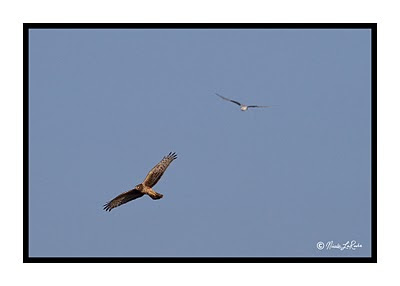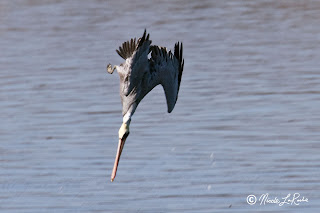The second post for today has photos that were also taken on last Thursday (10-21). On my way back home I stopped in Moss Landing because there was really good light and an otter close to the water's edge. All of these photos are of the same otter while she was grooming and getting ready to rest.
As well as a beautiful otter there were about 40 black-crowned night herons hanging around. This was really exciting because, like in the morning at Struve Slough, I have never seen so many night herons together in the same place!
Last Thursday I didn't have any plans to stop and take photos, but the animals called out to me and I ended up taking a lot of photos that day. This is why, no matter where I go, I always bring my camera!
Wednesday, October 27, 2010
Things that fly....
Today I am going to post 2 pages, the first having to do with 'Things that fly'
Last week on Thursday (10-21) while on my way to Santa Cruz I noticed over a hundred white pelicans at Struve Slough. That was a good reason to make a stop there, even though the light was not too great. I was very happy that I did! There were about a dozen different water bird species hanging out there. The ones that I was able to ID are:
Great Egret (Ardea alba)
Great Blue Heron (Ardea herodias)
Snowy Egret (Egretta thula)
Black-Crowned Night Heron (Nycticorax nycticorax, such a fun name!)
White Pelican (Pelecanus erythrorhynchos)
Cinnamon Teal (Anas cyanoptera)
Northern Shoveler (Anas clypeata)
Mallard (Anas platyrhynchos)
Double-Crested Cormorant (Phalacrocorax auritus)
American Coot (Fulica americana)
as well as some gulls and one bird I was unable to ID.
This first photo is of a black-crowned night heron and a great egret. While I see black-crowned night herons on a regular basis in Watsonville, I have never seen as many as I did this day. There were about fifteen spaced out around the slough.
This, again, is a black-crowned night heron sitting in a tree.
The white pelicans that come to Struve Slough do so usually to feed. Unlike their relatives, the brown pelican who dive into the water from the air, they dip their entire head into the water and muck up food.
Here are some more white pelicans, and two are fighting over resting space.
Like I said earlier, there were over 100 pelicans (and they are the reason why I stopped), so I had to get a shot of the clustered feeding they were partaking in.
Last week on Thursday (10-21) while on my way to Santa Cruz I noticed over a hundred white pelicans at Struve Slough. That was a good reason to make a stop there, even though the light was not too great. I was very happy that I did! There were about a dozen different water bird species hanging out there. The ones that I was able to ID are:
Great Egret (Ardea alba)
Great Blue Heron (Ardea herodias)
Snowy Egret (Egretta thula)
Black-Crowned Night Heron (Nycticorax nycticorax, such a fun name!)
White Pelican (Pelecanus erythrorhynchos)
Cinnamon Teal (Anas cyanoptera)
Northern Shoveler (Anas clypeata)
Mallard (Anas platyrhynchos)
Double-Crested Cormorant (Phalacrocorax auritus)
American Coot (Fulica americana)
as well as some gulls and one bird I was unable to ID.
This first photo is of a black-crowned night heron and a great egret. While I see black-crowned night herons on a regular basis in Watsonville, I have never seen as many as I did this day. There were about fifteen spaced out around the slough.
This, again, is a black-crowned night heron sitting in a tree.
The white pelicans that come to Struve Slough do so usually to feed. Unlike their relatives, the brown pelican who dive into the water from the air, they dip their entire head into the water and muck up food.
Here are some more white pelicans, and two are fighting over resting space.
Like I said earlier, there were over 100 pelicans (and they are the reason why I stopped), so I had to get a shot of the clustered feeding they were partaking in.
Sunday, October 17, 2010
Rainy Days
Since it is raining today here in Big Sur, I thought I would come up to town and use the internet. We are still internet-less in Big Creek. The plus side is that it gives me more time to edit my photos!
Today the theme of the photos is sea otters and harbor seals. These photos are from last month in Monterey at Otter Point.
This is a foraging otter near a hauled out harbor seal. The harbor seal was looking so far back at the otter that he/she fell off the rock right after this picture!
Two harbor seals. The seal in the water got up on the rock after this photo, which the already hauled out seal did not like- sharing is not what harbor seals are known for.
This female swam right past me with her prey item in hand. She later was the otter in the above photo with the harbor seal on the rock.
This female otter was looking for some tasty prey items up in the surf grass.
A harbor seal resting in the sun in Monterey.
This is a pup and mom otter- the mom is diving on the left. When she was done eating the abalone, she gave her pup the empty shell to play with and try to get any leftover meat.
This is a mom and pup otter. The mom is on the right- she is a tagged otter, you can see her yellow tag here.
This is the same mom and pup sharing an abalone. Otters will often break off a corner of the shell when prying the abalone off the rock. In this photo you can see the place where she broke off the shell.
Today the theme of the photos is sea otters and harbor seals. These photos are from last month in Monterey at Otter Point.
This is a foraging otter near a hauled out harbor seal. The harbor seal was looking so far back at the otter that he/she fell off the rock right after this picture!
Two harbor seals. The seal in the water got up on the rock after this photo, which the already hauled out seal did not like- sharing is not what harbor seals are known for.
This female swam right past me with her prey item in hand. She later was the otter in the above photo with the harbor seal on the rock.
This female otter was looking for some tasty prey items up in the surf grass.
A harbor seal resting in the sun in Monterey.
This is a pup and mom otter- the mom is diving on the left. When she was done eating the abalone, she gave her pup the empty shell to play with and try to get any leftover meat.
This is a mom and pup otter. The mom is on the right- she is a tagged otter, you can see her yellow tag here.
This is the same mom and pup sharing an abalone. Otters will often break off a corner of the shell when prying the abalone off the rock. In this photo you can see the place where she broke off the shell.
Wednesday, October 13, 2010
Today, a mish-mash of beautiful nature
Here are some more photos from the past week or so. Photos include a trip to the intertidal zone during low tide, some more bird photos from Long Marine Lab and a little view into part of my backyard! Enjoy!
First, some algae. This is Ahnfeltiopsis which is common where the rocky intertidal and sandy beach area meet. We went down to Mill Creek at the low tide (-0.6 feet) in the afternoon to check out some algae, invertebrates and a sunset.

These are gooseneck barnacles.
This is another photo from Long Marine Lab of a Northern harrier and a white-tailed kite flying together.
One of the great things about living in Big Creek is that I have an amazing backyard. This waterfall (Canogas Falls) is on the property and is breathtaking! Both photos were taken from the top tier of a three tier waterfall. The first is looking up at the large fall and the second is looking down at the bottom two tiers.
First, some algae. This is Ahnfeltiopsis which is common where the rocky intertidal and sandy beach area meet. We went down to Mill Creek at the low tide (-0.6 feet) in the afternoon to check out some algae, invertebrates and a sunset.

This is another photo from Long Marine Lab of a Northern harrier and a white-tailed kite flying together.
One of the great things about living in Big Creek is that I have an amazing backyard. This waterfall (Canogas Falls) is on the property and is breathtaking! Both photos were taken from the top tier of a three tier waterfall. The first is looking up at the large fall and the second is looking down at the bottom two tiers.
Tuesday, October 12, 2010
The early bird gets the worm, but the second mouse gets the cheese....
In the case of the yurt, the second mouse gets the peanut butter! That is more of an inside joke that only my fellow yurt dwellers may get...
Anyways, on to photos! I have been taking a bunch of bird photos lately. There are so many great things about birds, but as most know my favorite animal is the tiny hummingbird, no specific species. In Big Creek we have resident Anna's hummingbirds (Calypte anna) that visit the feeders and even visit while I am taking a shower. This female was up at Whale Point.
Anyways, on to photos! I have been taking a bunch of bird photos lately. There are so many great things about birds, but as most know my favorite animal is the tiny hummingbird, no specific species. In Big Creek we have resident Anna's hummingbirds (Calypte anna) that visit the feeders and even visit while I am taking a shower. This female was up at Whale Point.
And then this juvenile male Anna's on my way up the trail to Whale Point.
This is a female Northern harrier (Circus cyaneus) at Long Marine Lab in Santa Cruz. She was flying around along with two white-tailed kites (Elanus leucurus) but I have only edited this photo so far...
Like always, I am behind in the editing part of photograpy, but since I have time to upload photos today, I thought I would add these three for viewing.
Sunday, October 3, 2010
A new place for photos
I was trying to avoid the photos on facebook thing and haven't yet found a way to share photos.
These photos were taken in Morro Bay on 9-28-2010 with my Canon 7D and 100-400 lens.
Enjoy!
These photos were taken in Morro Bay on 9-28-2010 with my Canon 7D and 100-400 lens.
Enjoy!
Elegant terns
A patriotic brown pelican
A brown pelican diving and catching some food
Subscribe to:
Comments (Atom)






































